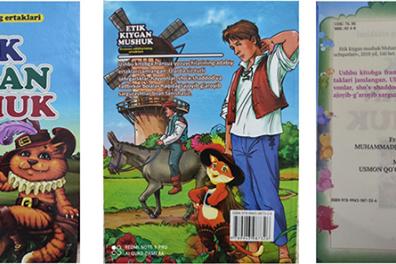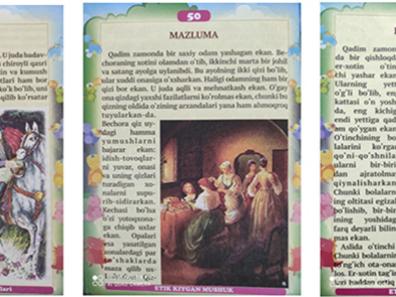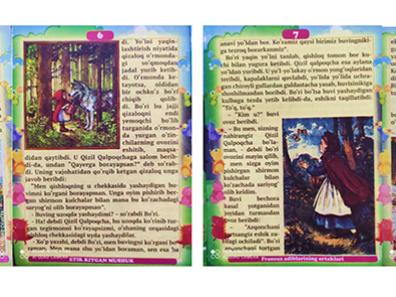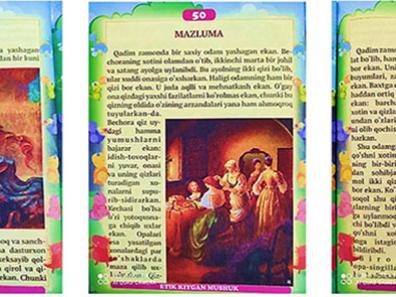French children's literature and translation-adaptation into Uzbek

His tales were published several times in almost every language in the world, and are still in print. Charles Perrault's merit in the field of fairy tales "is particularly emphasized by folklorists who have carried out extensive research on his work"[1].
French fairy tales in Uzbek
From the 1950s onwards, young Uzbek readers were able to read French fairy tales in their mother tongue, despite the publication of the much earlier Russian version (Turgenev I. Volshebniye skazki Perro. S.- Peterburg, Izdaniye M.O.Volf, 1867).Peterburg, Izdaniye M.O.Volf, 1867). Charles Perrault's fairy tales began to be translated, first from Russian and then, at the time of the Republic's independence (1991), from the original language. During the 50s and 70s of the 20th century, the best Uzbek poets Aziz Abdourazzoq and Choukroullo were also the best translators of Ch. Perrault's tales from their Russian versions.
After the Republic of Uzbekistan gained independence, Ch. Minovarov (from French into Uzbek), T. Alimov and Ilhom Zoïr (from Russian into Uzbek) began translating Perrault's fairy tales. Some of Ch. Perrault's fairy tales were translated into Uzbek several times, and some were translated from French and Russian. We can cite a few examples, such as "La Вelle au bois dormant" and "Cendrillon" (translations by M. Kholbekov and Ch. Minovarov - from French, T.Alimov - from Russian) and "Le Petit Chaperon rouge" (Ch.Minovarov - from French, I.Zoïrov - from Russian) while some tales are translated from French by two translators like M. Kholbekov and Ch. Minovarov. These are "La Вelle au bois dormant", "Cendrillon", "Le petit Рouсet", "Le Сhat botté", "Les Fées", "Barbe-Bleue" and "Riquet à la Houppe".
This phenomenon is very interesting and useful, as the multitude of translations of the best texts of world literature or the retranslation of the same works in one language is one of the factors serving to improve the quality of translations and create adequate translations.

The drive to achieve the highest quality in translation continues unabated: "Lately in translations we read simple writings 'made from English, German, French', we recognize in translation the need for knowledge, not only of the language from which we are translating, but also of the customs and traditions, ways of life, characters and psychologies of the people who speak that language[2]"[3].
The strict observance of national identity is one of the greatest requirements of literary translation of literary masterpieces by foreign peoples. In recent years, our translators have been creating adequate translations. However, even the best translations have their shortcomings, which can lead to disorientation with regard to the original work.
Analysis of Uzbek translations of Ch. Perrault's tales
We have analyzed the reproduction of French realias[4] in Uzbek translations, as well as other difficulties that translators may come up against during their work on the original tales by Ch. Perrault; and Russian and Uzbek translations of the tales by Ch.Minovarov, M.Kholbekov, T.Alimov, I.Zoïrov and A.Akbar.
However, as Isabelle Nieres-Chevrel, Emeritus Professor of General and Comparative Literature and researcher on children's literature at the Université de Haute-Bretagne - Rennes II, points out, problems of linguistic and cultural distance arise in the translation of children's books, as in any translation. At first glance, all translations appear adequate and faithful, but their comparison with the originals shows certain dissonances, as below, in the analysis of originals and translations of the tales "Little Red Riding Hood" and "Cinderella".
However, there is a certain specificity to children's literature, as the translator cannot avoid thinking that he is writing for an audience whose linguistic and cultural competence is not his own. The problem of linguistic discrepancy should be the same as that which arises for any translation, but with greater acuity in the case where the original text was originally intended for young people[5].
"Little Red Riding Hood" is the most translated into Uzbek among Ch. Perrault's tales. It has been translated seven times; by A.Abdourazzoq, Choukroullo, T.Alimov, I.Zoïrov and A.Akbar from Russian versions, by Ch.Minovarov and M.Kholbekov from French.

For example, "Little Red Riding Hood", in French:
One day her mother, having baked and made galettes, said:
Go and see how your mother-grandmother is doing, for I've been told she's ill, take her a galette and this little pot of butter[6].
Ch.Minovarov's translation:
Bir kuni onasi koulchalar pishirib, unga debdi:
O'zing bilan birga mana bou koulchalardan va khourmatchadagi sarighmoydan olvolgin[7].
The Russian translation:
Как-то раз испекла мама пирожок и сказала дочке:
Сходи-ка ты Красная шапочка и пошла к бабушке, снеси ей этот пирожок и горшочек масла, да узнай, здорова ли она[8].
Ilhom Zoïrov's translation:
Bir kouni onasi bo'ghirsoq pichirib, qiziga dedi:
Qizil qalpoqcha, sen mana bou bo'ghirsoq va khourmatchadagi moyni olib bor-da, bouvning soghlighini bilib kel[9].
The following translation was made by A.Akbar from Russian:
Bir kouni qiztchaning onasi bo'ghirsoq pichiribdi-da:
Qizil qalpoqcha, mana bou ko'zatchadagi yogh bilan bo'ghirsoqlarni olib, bouvingni ko'rib kel, - debdi[10].
As we said above, while Ch.Minovarov did the translation from the original, I.Zoïrov and A.Akbar did it from the Russian version dated 1937, Fabrika detskoy knigi izdatelstvo detskoy literaturi edition, TsK VLKSM, Moscow. The translator is unknown. (Earlier, Turgenev I. Volshebniye skazki Perro. S.-Peterburg, Izdaniye M.O.Volf, 1867.).
In Ch.Minovarov's translation "une galette" becomes "de petites galettes", while in I.Zoïrov and A.Akbar it is "une crêpe rôtie dans la poêle", and in the Russian version it appears as "gâteau-pirojok".
Moreover, in Ch.Minovarov, the mother tells her daughter to take a tiny bit of "butter" from the pot, while the mothers of I.Zoïrov and A.Akbar say to take "the whole pot of butter" as in the Russian version. Here, we can't blame I.Zoïrov and A.Akbar for the fact that the French "une galette" has been transformed in Uzbek into "une crêpe rôtie dans la poêle", as they have remained faithful to the Russian version of the tale on which they based themselves. Unlike Ch.Minovarov, I.Zoïrov and A.Akbar do not know French, but they are truly experienced literary translators from other languages. They have worked and still work as professional editors in publishing houses. But at a time when it has been confirmed that a good knowledge of French is not enough for an adequate translation of French literature into Uzbek, and that a good cultural knowledge and a man of letters are needed for a better translation, the lack of skills leads them both to act blindly.
"They are then only approximations at best, or fleeing in the face of difficulty, or even ignoring the difficulty through ignorance of the source language. The fault lies with the publisher, for whom the mere success of a work in another country is reason enough for publication; he doesn't much care whether the work is "translatable", i.e. whether the linguistic gap can be bridged. And, in any case, it can only be bridged by a translator of high linguistic competence in both the source and target languages. [11]"
Another example, the little girl's psychology, her simplicity, can be seen in her encounter with the Wolf:
He asked her where she was going; the poor child, who didn't know that it's dangerous to stop and listen to a Wolf, told him:
I'm going to see my Granny, and take her a wafer with a little pot of butter that my Mother is sending her[12].
Here, in Little Red Riding Hood's conversation with the Wolf, the writer shows that children are unaware of the misfortune that threatens them, as well as their trust in others. Above all, the storyteller warns his readers: "the poor child, who didn't know that it's dangerous to stop and listen to a Wolf". In Abdurahman Akbar's translation, even if we sense the threat, we don't sense the writer's concern:
Qizil Qalpoqcha bo'rilar bilan gaplashish xavfli ekanini xayoliga keltirmas ekan[13].
In French: "Le Petit Chaperon rouge ne savait pas qu'il est dangereux de discuter avec les loups".
To achieve his goal, the clever wolf lies to the little girl. And Little Red Riding Hood sincerely believes him.
In French:
- Hé bien, dit le Loup, je veux aller voir aussi; je m'en vais par ce chemin ici, et toi par ce chemin-là, et nous verrons qui plus tôt y sera[14]. (underlining is to Rakhimova G.)
- Ha! - debdi bo'ri, - mening ham buvingni ko'rgim kelyapti. Yaxshisi, men buy yo'ldan, sen unisidan ket. Qani kim oldin yetib borarkin.
Abdurahman Akbar's Uzbek translation corresponds entirely to the original. The children believe in the suggested games as underlined. And the Wolf takes advantage of their naïveté.
The Wolf takes the shortest route, and is of course the first to arrive.
In the original, Little Red Riding Hood is in no hurry, walking very slowly, stopping several times to pick hazelnuts and flowers:
....the little girl set off along the longest path, amusing herself by picking hazelnuts, chasing butterflies, and making bouquets of the little flowers she came across[15].
Abdourahman Akbar's version of the above sentence is quite short:
Qizil Qalpoqcha uzoghidan ketibdi, yo'l-yo'lakay to'khtab, goullar teribdi[16]
[Little Red Riding Hood took the longer way, stopped several times to pick flowers.]
The translator should always have recourse to Denise Escarpit's ideas: "the adult, translator of an adult, author of a work intended for adults, must take into account the enormous gap that exists between his own cultural references and those of his young reader: a quantitative as well as qualitative gap. The translator, a sort of mediator between two languages and two cultures, is also the mediator between two levels of culture, and often between two levels of linguistic understanding. "17] The translator, therefore, must be aware of and grasp the nuances between the readers' cultural and linguistic understanding, but also the perception, the child's vision of the world too.
"Buvinikiga yetib kelgan uning soddaligidan foydalanib uyga kirib oladi va "kampirga tashlanib shu zahotiyoq uni yutib yuboradi"[18] .
[The Wolf, who arrived first at the grandmother's, enters the house taking advantage of her simplicity, pounces on her and immediately swallows her]
In the original version:
He pounced on the good woman, and devoured her in no time; for it had been more than three days since he had eaten[19].
Little Red Riding Hood, who arrives second at her grandmother's, chats with the Wolf behind the door. Here, too, we observe the girl's naiveté. Although she is surprised by Wolf's rude voice, she believes it to be that of her grandmother. The original version reads:
Little Red Riding Hood, hearing the Wolf's coarse voice, was frightened at first, but believing her grandmother to have a cold, answered...
His Uzbek translation by A.Akbar:
Uning qo'pol, bo'ghiq ovozini eshitgan Qizil Qalpoqtcha avvaliga qo'rqib ketibdi, keyin bouvisining shamollagani yodiga touchib[20]...
In the original Little Red Riding Hood, after listening to the Wolf's harsh voice, believes her grandmother may have a cold. In the Uzbek translation, she remembers that her "grandmother had a cold". The Uzbek translation is always adapted.
In the original version:
"The Wolf, seeing her come in, said to her, hiding in bed under the blanket:
-Put the wafer and the little pot of butter on the hutch, and come and lie down with me."[21]
In the Uzbek translation by A.Akbar:
Qizcha ouyga kirganida ko'rpaga bourkanib olgan bo'ri:
- Bo'ghirsoqni xontaxta oustiga, ko'zachani tokchaga qo'ygin-da, o'zing yonimga kelaqol. Hoynahoy charchab kelgandirsan, - debdi[22].
"The hutch" (Huche, n.f. (from germ.) 1. Chest or small piece of furniture for storing bread. 2. Large medieval chest with flat lid, which could be used as a seat. )[23] is transformed into an Uzbek "coffee table".
Here, a question arises: isn't there also a desire to modernize the text?
As mentioned, it's the translator's lack of linguistic and cultural skills that :
"anchoring the reader in the world in which he lives and depriving him of any possibility of comparison with other times or other places, thus denying him the historical and cultural hindsight without which there can be no sound assessment of the present, finally preventing him from taking action and applying his critical sense[24]".
Translators always seek to give cultural equivalents that reflect the text's temporal remoteness, and archaisms are dealt with by defining a word. However, the cultural equivalent of the word "La huche" exists in Uzbek "non quti - a wooden box for storing bread". While the "xontaxta" of the Uzbek translation is a table with four low legs where one eats.
Little Red Riding Hood, who has approached her grandmother, is astonished to see her "in her undress":
"Little Red Riding Hood undressed, and went to get into bed, where she was quite astonished to see how her Grandmother was made in her undress."
In the Uzbek translation this situation is absent. Nor does it exist in Abdourahmon Akbar's translation from the Russian version of the tale, or in Ch. Minovarov's translation from the French original.
As Bernard Friot notes, "translators (and editors) often tend to adapt the source text to conform to a vision of the world and of childhood that they feel is more readily assimilated by the intended reader. They generally project their own pedagogical conceptions, in a word their ideology, for fear of confusing or shocking the young reader ... [25]"
In the following conversation between Little Red Riding Hood and "Mother-grandmother", we witness the little girl's naiveté. She tells her:
Mother-grandmother, that you have big arms?
The better to kiss you with, my daughter.
Mother-grandmother, that you have big legs?
The better to run with, my child.
Mother-grandmother, that you have big ears?
The better to kiss you with, my daughter.
Mother-grandmother, that you have big legs?
The better to run with, my child.
Mother-grandmother, that you have big ears?
- It's the better to listen, my child.
- My mother-grand, that you have big teeth?
- It's the better to eat you[26].
A.Akbar's Uzbek translation:
- Bouvijon, qo'llaringiz mountcha katta? - deb so'rabdi ou.
- Bou seni mahkam qoutchoqlachim outchoun, bolajonim !
- Bouvijon, oyoqlaringiz mountcha katta?
- Tez yougourich outchoun, bolajonim !
- Bouvijon, qouloqlaringiz mountcha katta?
- Yaxchi echitich outchoun, bolajonim!!
- Bouvijon, ko'zlaringiz mountcha katta?
- Yaxchiroq ko'richim outchoun, bolajonim!
- Bouvijon, tichlaringiz mountcha katta?
- Tezroq seni yeyichim outchoun, bolajonim[27] !
The conversation between the Wolf and Little Red Riding Hood faithfully translates the source text, retaining all the childlike imagination and making it both amusing and a real eye-opener for young readers of the target language. All the nuances of the original are well preserved in Uzbek.
The little girl's naivety and lack of common sense is the cause of her misfortune - the Wolf eats her:
And saying these words, that wicked Wolf pounced on Little Red Riding Hood, and ate her[28].
His Uzbek translation:
Qizil Qalpoqcha nima gapligini anglashga ham ulgurolmay qolibdi. Yovuz bo'ri uni jajji kovushchalari-yu, ajoyib qalpoqchasi bilan birga yutib yuboribdi[29].
[Little Red Riding Hood couldn't understand what it was all about. The wicked Wolf threw himself on her and swallowed her with his little shoes and his cute little red hat.]
Here, if the translator adds "her little shoes and her amazing little red hat" absent in the original, he manages to enrich the image of the little girl while at the same time emphasizing the lack of common sense: "Little Red Riding Hood couldn't understand what it was all about".
The tale ends on a highly instructive note, as in all of Ch. Perrault's tales, "Little Red Riding Hood" also presents a morality. However, the morality of "Little Red Riding Hood" is not translated, as in all other Uzbek translations of Ch. Perrault's tales.
The translator, a sort of mediator between two languages and two cultures, is also the mediator between two levels of culture and often between two levels of linguistic understanding. "Faced with these difficulties, the temptation is great - and all the more understandable as translators are so poorly paid - to reduce the cultural gaps and even erase them," writes D. Escarpit.
The translator is a mediator between two languages and two cultures.

Tale title translation
It's still worth pointing out that the title of every work presents a certain meaning, and in its translation its title also presents importance.
The title, on the one hand, brings the reader into the microcosm of the work, while at the same time serving as a kind of introduction, including prospective information on subsequent events; on the other hand, it reveals, as retrospective interpretation proceeds, all the logical, semantic, structural and linguistic signals of the text. "The title is a revealed graphic sign of the text expressed by the means of language, which presents an autonomous semantic, an initial and unique element for the whole text, and which states and/or characterizes the text by prognosticating and integrating its content as well as informing complementary meanings[30]".
Let's look at the translations of story titles. Three translations of a single title: "Cinderella or the Little Glass Slipper" - "Kouloyim yoki billour bochmoqtchalar" ("Cinderella or the Glass Slippers", Ch.Minovarov) - "Mazlouma" ("The Prisoner", M.Kholbekov) - "Choumchouk qiz" ("The Well-to-do Girl", T.Alimov).
Two translations of a single title: "The Master Cat or the Puss in Boots" - "Ustasi farang yoki etik kiygan mouchouk" ("The Master of His Profession or the Puss in Boots", Ch.Minovarov) - "Etik kiygan mouchouk" ("Puss in Boots", M.Kholbekov) etc.
"Francization and actualization are the most frequent forms of this refusal of ethnic or historical difference [31]", writes I. Nières. Giving as an example the translation of Louisa May Alcott's American title "Little women" as "Les quatre filles du Docteur March" ("The four daughters of Doctor March").
However, these notes are very much about the translation of the French title "Le Maître Chat ou le Chat botté" ("The Master Cat or the Puss in Boots") too. For the title "Ustasi farang yoki etik kiygan mouchouk" ("The master of his profession or the booted cat", Ch.Minovarov) is directly linked with French and the French. The expression "Ustasi farang" - meaning "French Master", (Farang, from Uzbek - a Frenchman" who is representative of a great people of his time contributing enormously to world civilization by giving the world great political, literary, artistic men in particular, in the 19th and 20th centuries in Central Asia this expression was used in two senses - broad and narrow - in the narrow sense it meant "a Frenchman" (a citizen, a nation), while in the broad sense it meant "a European". In other words, when we used this word, we were first recognizing a Frenchman and then a European. In fact, the expression "Ustasi farang" - "French Master" - is interpreted from the mastery, creativity and ingenuity of the French people, who are masters of their art.
Ch. Perrault's literary tales are not mere entertainment. They are rich in learning, because the adventures of the characters serve as examples, provide food for thought and offer lessons that sharpen the young reader's eye and intelligence. So young people need to read and learn from literature, translations and adaptations.
Gulsanam RAKHIMOVA
Teacher-researcher, lecturer in FLE
National University of Uzbekistan (Tashkent)
Mel: View e-mail
BIBLIOGRAPHICAL NOTICE
Dadaboyev S. Current problems in Romance and Germanic linguistics. Tashkent, 2009.
ESCARPIT, Denise. Traduction et adaptation en littérature d'enfance et de jeunesse, Pessac: Nous voulons lire!, 1985.
Friot, Bernard. Traduire la littérature pour la jeunesse. "Le français aujourd'hui", 2003/3№ 142, p.p 47-54.
Janob Segenning echkisi (La chèvre de monsieur Seguin). Literary tales by French writers. - Tashkent: Youldouztcha, 1989.
Karimov Ch. Herman Hesse va jahon adabiyoti // Adabiy aloqalar, adabiy tas'ir va tarjimachunoslikning dolzarb masalalari. Т., 2010.
Kukharenko V.A. Interpretasiya teksta. - Moscow: Prosvechenye, 1982.
Le Petit LAROUSSE illustré. Paris, 2004, p.554.
NIERES-CHEVREL, Isabelle. - "La traduction dans les livres pour la jeunesse", La Littérature de jeunesse (CRDP Rennes), 1980, p. 63-103.
Perrault Charles. Contes de ma mère l'Oye. - Paris, 2002.
Perro Sharl. Ona Ghoz ertaklari. - Tashkent, Editions Charq, 1996.
Perro Sharl. Skazki. - Leningrad, 1968.
Perro Sharl. Qizil qalpoqcha. - Tashkent, Gafur G'ulom nomidagi nashriyot-matbaa ijodiy uyi, 2010.
Perro Sharl. Qizil qalpoqcha. - Tashkent, Cho'lpon nomidagi nashriyot-matbaa ijodiy uyi, 2011.
[1] Dadaboyev S. Les problèmes actuels da la linguistique romane et germanique, Tashkent, 2009, p. 335.
[2] Karimov Ch., "Herman Hesse va jahon adabiyoti", Adabiy aloqalar, adabiy tas'ir va tarjimashunoslikning dolzarb masalalari,Тachkent, 2010.
[3] Translation is to Rakhimova G.
[4] Elements specific to a language and culture.
[5] NIERES-CHEVREL, Isabelle. - "La traduction dans les livres pour la jeunesse", La Littérature de jeunesse (CRDP Rennes), 1980, p. 63-103.
[6] Perrault Charles, Contes de ma mère l'Oye, Paris, éd. cit., 2002, p. 8.
[7] Perro Sharl. Ona Ghoz ertaklari, Tashkent, Editions Charq, 1996, p. 18.
[8] Perro Sharl. Krasnaya shapochka. Knijka-malishka. Fabrika detskoy knigi izdatelstvo detskoy literaturi edition, TsK VLKSM, Moscow, 1937.
[9] Perro Sharl. Qizil qalpoqcha, Tashkent, Gafur G'ulom nomidagi nashriyot-matbaa ijodiy uyi, 2010, p. 10.
[10] Perro Sharl. Qizil qalpoqcha, Tashkent, Cho'lpon nomidagi nashriyot-matbaa ijodiy uyi, 2011, p. 3.
[11] ESCARPIT, Denise. Traduction et adaptation en littérature d'enfance et de jeunesse, Pessac: Nous voulons lire!, 1985.
[12] Perrault Charles, Contes de ma mère l'Oye, ed. cit., p. 23.
[13] Perro Sharl, Qizil qalpoqcha, 2011, ed. cit., p. 5.
[14] Perrault Charles, Contes de ma mère l'Oye, éd. cit., p. 23.
[15] Ibid., p. 23-24.
[16] Perro Sharl, Qizil qalpoqcha, 2011, éd. cit., p. 5.
[17] ESCARPIT, Denise. Traduction et adaptation en littérature d'enfance et de jeunesse, Pessac: Nous voulons lire!, 1985.
[18] Ibid. p. 8.
[19] Perrault Charles, Contes de ma mère l'Oye, ed. cit., p. 2.
[20] Perro Sharl, Qizil qalpoqcha, 2011, ed. cit., p. 11.
[21] Perrault Charles, Contes de ma mère l'Oye, ed. cit., p. 23.
[22] Id.
[23] Le Petit LAROUSSE illustré. Paris, 2004, p.554.
[24] ESCARPIT, Denise. Traduction et adaptation en littérature d'enfance et de jeunesse, Pessac: Nous voulons lire!, 1985.
[25] Friot, Bernard. Traduire la littérature pour la jeunesse. "Le français aujourd'hui", 2003/3№ 142, p.p 47-54.
[26] Perrault Charles, Contes de ma mère l'Oye, éd. cit., p. 24.
[27] Perro Sharl, Qizil qalpoqcha, 2011, éd. cit., p. 12.
[28] Perrault Charles, Contes de ma mère l'Oye, éd. cit., p. 24.
[29] Perro Sharl, Qizil qalpoqcha, 2011, ed. cit. p. 12.
[30] Kukharenko V.A. Interpretasiya teksta, Moscow, Prosvechenie, 1982.
[31] NIERES-CHEVREL, Isabelle. - "La traduction dans les livres pour la jeunesse", La Littérature de jeunesse (CRDP Rennes), 1980, p. 63-103.